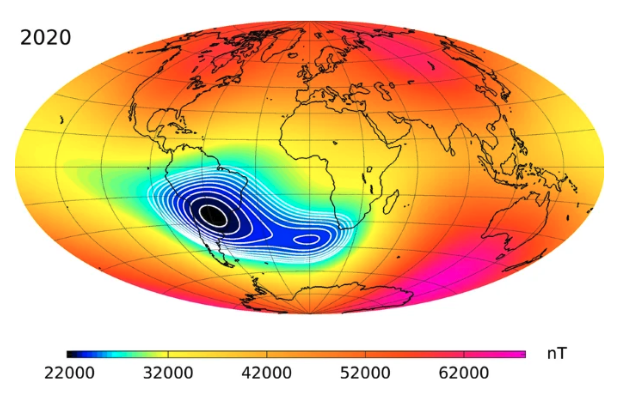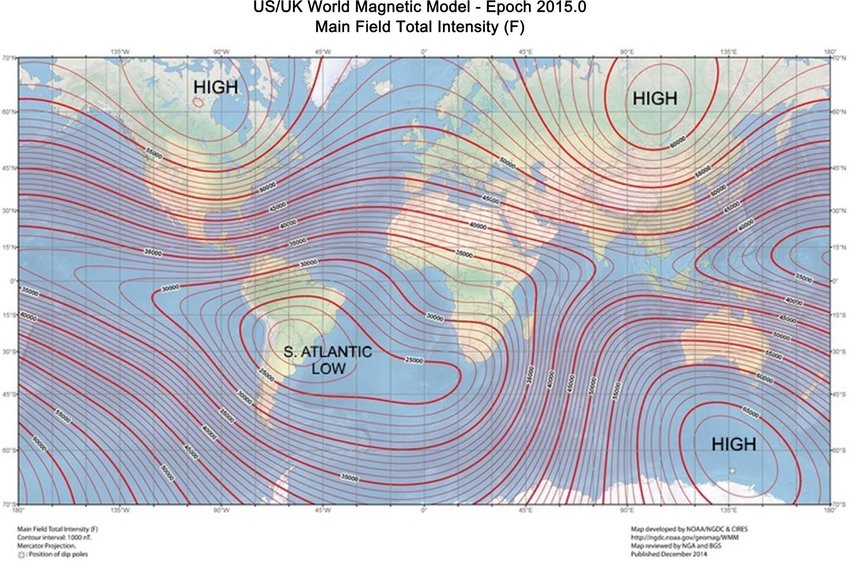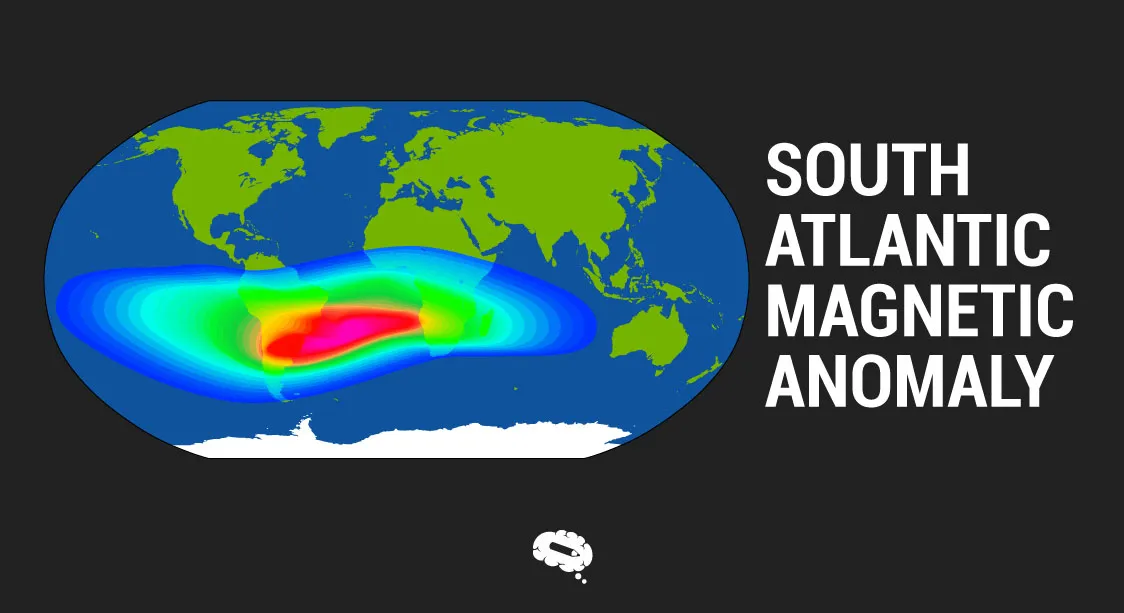The South Atlantic Magnetic Anomaly (SAMA) is one of the most intriguing and significant features in the study of Earth’s geomagnetic field. Located over the South Atlantic Ocean, this anomaly is characterized by an unusually weak magnetic field compared to the surrounding areas. It extends roughly from the southern tip of South America to the mid-Atlantic Ridge, encompassing parts of Brazil and Angola. The anomaly is not just a curious geological feature but a focal point for understanding the complexities and dynamics of Earth’s magnetic field.
As this article delves deeper into the South Atlantic Magnetic Anomaly, you’ll uncover more about its origins, current behavior, and potential future developments. This exploration not only enhances our comprehension of Earth’s magnetic environment but also explains the potential challenges arising from this unique geomagnetic feature.

What is the South Atlantic Magnetic Anomaly?
The South Atlantic Magnetic Anomaly (SAMA) is a region of Earth’s magnetic field characterized by an unusually low intensity of the magnetic flux density compared to other areas on the planet. This anomaly is situated over the South Atlantic Ocean and extends over parts of South America and Africa. The magnetic field strength in this region is significantly weaker than the global average, making it a focal point for scientific research and technological consideration.
The South Atlantic Magnetic Anomaly is part of a broader phenomenon known as geomagnetic secular variation, which involves changes in the Earth’s magnetic field over time. Its distinctive feature is the notable decrease in magnetic field strength, which contrasts sharply with the more robust magnetic field observed in other regions.
Importance
The South Atlantic Magnetic Anomaly is of great interest to scientists and engineers for several reasons:
- Scientific Research: Understanding the SAMA provides insights into the dynamics of Earth’s geomagnetic field and the processes occurring in the planet’s outer core. Studying the anomaly helps researchers model the behavior of the geodynamo—the mechanism that generates Earth’s magnetic field—and track its variations over time. This knowledge is crucial for understanding the long-term changes in Earth’s magnetic field and its impact on the planet’s environment.
- Impact on Earth: The weakened magnetic field in the SAMA region results in increased exposure to cosmic and solar radiation. This can have various effects on both natural systems and human-made infrastructure. For example, increased radiation levels can influence atmospheric processes and potentially impact climate patterns.
- Technological Implications: The SAMA poses specific challenges for technology and space missions. Satellites passing through this region experience higher levels of radiation, which can lead to electronic malfunctions and damage. This can affect satellite performance, communications, and data integrity. Additionally, the anomaly can interfere with global navigation systems, as variations in the magnetic field may influence compass readings and navigation accuracy.
In summary, the South Atlantic Magnetic Anomaly is a significant feature of Earth’s magnetic field with far-reaching implications for both scientific understanding and technological operations. Its study helps advance our knowledge of geomagnetic processes and informs strategies to mitigate the effects on technology and infrastructure.
Causes of the South Atlantic Magnetic Anomaly
To understand the South Atlantic Magnetic Anomaly (SAMA), it is essential to explore the factors contributing to its formation. This anomaly is not an isolated phenomenon but rather a manifestation of broader processes affecting Earth’s magnetic field. Investigating the underlying causes provides insight into how such anomalies arise and what they reveal about Earth’s dynamic systems.
The origins of the South Atlantic Magnetic Anomaly are rooted in the fundamental workings of Earth’s magnetic field and the geological processes influencing it. By examining the basics of geomagnetic field generation and the specific geological factors involved, a clearer picture of this intriguing magnetic feature emerges.
The following sections will delve into the fundamental principles of Earth’s magnetic field and how the SAMA fits into this larger context, followed by an exploration of the geological factors and current theories explaining its existence and behavior.
Earth’s Magnetic Field
Earth’s magnetic field, also known as the geomagnetic field, is generated by the movement of molten iron and other materials in the planet’s outer core. This movement creates electric currents, which in turn generate magnetic fields. The combined effect of these fields produces a complex, dynamic magnetic environment that extends from the core to the space surrounding Earth.
The geomagnetic field is generally dipolar, meaning it has two main poles—north and south—that are roughly aligned with the planet’s rotational axis. However, this field is not perfectly uniform; it exhibits variations due to the irregularities in the flow of molten iron in the outer core, as well as influences from the Earth’s crust and mantle.
The South Atlantic Magnetic Anomaly represents a significant deviation from the normal geomagnetic field. In this region, the magnetic field strength is substantially lower than the global average. This anomaly does not fit neatly into the dipolar model of the geomagnetic field and instead represents a localized weakening of the magnetic flux density. Understanding how the SAMA fits into the broader geomagnetic system requires examining the interplay between the Earth’s core processes and surface characteristics.

Geological Factors
The South Atlantic Magnetic Anomaly is believed to be influenced by several geological and geophysical factors:
- Geodynamo Dynamics: The primary driver of Earth’s magnetic field is the geodynamo, which involves the movement of molten iron in the outer core. Variations in the flow and temperature of this molten material can lead to fluctuations in magnetic field strength. The SAMA is thought to be associated with a region where the geodynamo’s processes are less efficient, resulting in weaker magnetic field strength.
- Mantle Convection: Another contributing factor could be the patterns of mantle convection. The flow of material in the Earth’s mantle affects the distribution of heat and the dynamics of the outer core. Variations in mantle convection can influence the geodynamo and, consequently, the strength and distribution of the geomagnetic field.
- Crustal Influences: The Earth’s crust and upper mantle can also play a role in shaping the magnetic field. Localized variations in magnetic properties due to the presence of different types of rocks or mineral deposits can contribute to the formation of anomalies like the SAMA. These crustal effects can modulate the overall magnetic field in specific regions.
- Current Theories and Research: Recent research has focused on understanding the interactions between these various factors to better explain the SAMA. Studies using satellite data and computer simulations have provided insights into the behavior of the geodynamo and its impact on the magnetic field. For example, researchers have investigated how the weakening of the magnetic field in the SAMA region might be related to broader trends in geomagnetic field strength and polarity reversals.
Effects of the South Atlantic Magnetic Anomaly
The South Atlantic Magnetic Anomaly (SAMA) has notable effects on various technological systems, primarily due to its influence on Earth’s magnetic field. Understanding these effects is crucial for mitigating potential disruptions and enhancing the resilience of technological and navigational systems that operate in or near the anomaly’s region.
This section examines the impact of the SAMA on two critical areas: satellites and navigation systems. The anomaly’s weakened magnetic field can lead to significant challenges for space missions and satellite operations, while its effects on navigation systems can disrupt the accuracy of both aerial and maritime navigation. By exploring these impacts, one can appreciate the broader implications of the SAMA on modern technology and infrastructure.
Impact on Satellites
The South Atlantic Magnetic Anomaly (SAMA) significantly affects satellites and space missions due to the increased radiation levels in this region. The weakened magnetic field allows more cosmic and solar radiation to penetrate, which can have several detrimental effects on satellite operations and performance.
How the Anomaly Affects Satellites and Space Missions
Satellites traversing the SAMA encounter elevated radiation levels, which can lead to disruptions in their electronic systems. This increased radiation exposure can result in data corruption, malfunctions in electronic components, and potential damage to sensitive instruments. The anomaly’s effects can compromise satellite functionality, including its communication systems and onboard sensors, impacting data integrity and mission success.
Specific Examples of Satellite Malfunctions
Several satellites have experienced issues linked to the SAMA. For instance:
- Hubble Space Telescope: The Hubble Space Telescope has encountered temporary malfunctions and data anomalies when passing through the SAMA, attributed to radiation-induced interference.
- GOES-13: This weather satellite experienced problems with its sensors and communication systems during its passages through the SAMA, affecting weather monitoring capabilities.
These examples illustrate how the SAMA’s radiation environment can impact satellite operations, underscoring the need for careful planning and shielding to mitigate these effects.
Impact on Navigation
The South Atlantic Magnetic Anomaly also disrupts navigation systems, affecting both aerial and maritime navigation. The weakened magnetic field in this region can lead to inaccuracies in magnetic-based navigation systems, which rely on stable magnetic field readings.
How It Disrupts Navigation Systems
Magnetic compasses and other navigation systems that rely on Earth’s magnetic field can experience deviations when operating within the SAMA. This can lead to incorrect readings, requiring compensatory adjustments to maintain accurate navigation. The anomaly’s impact is particularly pronounced for systems that depend on precise magnetic field measurements.
Effects on Aircraft and Ships
For aircraft, the SAMA can lead to discrepancies in onboard navigation systems, potentially affecting flight paths and safety. Pilots may need to account for increased magnetic interference, which can complicate navigation and require additional verification using alternative systems.
In maritime navigation, ships relying on magnetic compasses or GPS systems can experience navigational errors or reduced accuracy when operating within the SAMA. This can affect route planning and navigation, necessitating additional checks and reliance on supplementary navigational aids.
Overall, the South Atlantic Magnetic Anomaly poses challenges for navigation systems, impacting both air and sea travel by introducing potential inaccuracies and requiring adjustments to ensure reliable and accurate navigation.
Research and Studies
The South Atlantic Magnetic Anomaly (SAMA) has garnered significant attention from the scientific community due to its impact on Earth’s magnetic field and technological systems. As researchers and institutions continue to investigate this anomaly, new insights are being gained into its causes and effects. Ongoing research and technological advancements are crucial for understanding and mitigating the challenges posed by the SAMA.
This section provides an overview of the current research efforts focused on the SAMA, highlighting key organizations and institutions involved in studying the anomaly. It also explores the technological advancements developed to address the challenges associated with the SAMA and outlines potential future directions in research.
Ongoing Research
Numerous organizations and institutions are dedicated to studying the South Atlantic Magnetic Anomaly, driven by its significance for both scientific understanding and practical applications.
Organizations and Institutions Studying the Anomaly
- NASA: The National Aeronautics and Space Administration (NASA) conducts extensive research on the SAMA through its space missions and satellite observations. NASA’s space missions provide valuable data on the anomaly’s impact on satellites and help refine models of Earth’s magnetic field.
- ESA: The European Space Agency (ESA) also plays a critical role in studying the SAMA. ESA’s space missions, such as the Swarm satellite mission, focus on mapping Earth’s magnetic field and investigating regional anomalies, including the SAMA.
- National Geographic Society: This organization supports research on geomagnetic phenomena and funds studies aimed at understanding the broader implications of the SAMA on Earth’s environment.
Current Missions and Studies
- Swarm Satellite Mission: ESA’s Swarm mission, launched in 2013, is a key project in the study of Earth’s magnetic field. The mission aims to provide detailed data on the magnetic field and its anomalies, including the SAMA, by deploying a constellation of three satellites.
- NASA’s Magnetic Field Missions: NASA’s missions, such as the Magnetic Field Investigation (MFI), focus on understanding the dynamics of Earth’s magnetic field and its variations, including those observed in the South Atlantic region.
- Geophysical Research Studies: Ongoing research by geophysicists and researchers from various institutions explores the underlying mechanisms of the SAMA and its interaction with the geodynamo and mantle convection.
Technological Advancements
Advancements in technology are helping to address the challenges posed by the South Atlantic Magnetic Anomaly. Innovations in satellite design and navigation systems are crucial for mitigating the effects of the anomaly and improving operational reliability.
New Technologies Developed to Deal with the Anomaly
- Radiation Shielding: New technologies in radiation shielding have been developed to protect satellites from increased radiation exposure in the SAMA region. Advanced materials and shielding techniques help reduce the risk of electronic malfunctions and damage.
- Enhanced Navigation Systems: Improved navigation systems that integrate multiple sources of data, including GPS and inertial measurement units, are being developed to compensate for the magnetic field distortions caused by the SAMA. These systems provide more accurate and reliable navigation information.
- Data Correction Algorithms: Researchers are developing advanced data correction algorithms to account for the magnetic field anomalies. These algorithms help filter out distortions in data collected from satellites and navigation systems, enhancing overall accuracy.
Future Directions in Research
- Advanced Geomagnetic Models: Future research aims to develop more precise models of Earth’s geomagnetic field that incorporate detailed data on anomalies like the SAMA. These models will improve predictions of field variations and their effects.
- Long-Term Monitoring: Continued long-term monitoring of the SAMA and its changes is essential for understanding its behavior and predicting future impacts. Ongoing satellite missions and ground-based studies will contribute to a more comprehensive understanding of the anomaly.
- Innovative Spacecraft Design: Future spacecraft and satellite designs will incorporate advanced technologies to better withstand the effects of the SAMA. Research into new materials and engineering solutions will enhance the durability and performance of space missions operating in this region.
Potential Challenges
The South Atlantic Magnetic Anomaly (SAMA) presents a range of challenges that impact both scientific research and practical applications. These challenges arise from the anomaly’s effects on technology, navigation, and our understanding of Earth’s magnetic field. Addressing these challenges requires ongoing research and innovative solutions.
Technological Challenges
- Satellite Vulnerabilities: Satellites passing through the SAMA are exposed to higher levels of radiation, which can cause electronic malfunctions, data corruption, and even physical damage to sensitive components. This increased radiation can affect satellite performance, leading to issues with communication, data transmission, and overall mission reliability.
- Radiation-Induced Failures: The anomaly’s radiation environment can induce failures in electronic systems onboard satellites and space missions. This includes the risk of electronic component degradation, increased error rates in data processing, and potential short-term or long-term operational disruptions.
- Increased Operational Costs: Addressing the impacts of the SAMA often requires additional resources, such as enhanced shielding for satellites or more frequent maintenance and calibration. These measures can increase the cost of space missions and satellite operations.
Navigation and Operational Challenges
- Inaccurate Magnetic Field Measurements: The SAMA introduces significant deviations in magnetic field readings, which can affect systems relying on magnetic compasses or magnetic-based navigation technologies. These inaccuracies can complicate navigation tasks, requiring pilots and ship navigators to use supplementary systems or perform additional checks.
- Flight Path Adjustments: For aircraft, the magnetic field distortions caused by the SAMA can lead to inaccuracies in onboard navigation systems, potentially requiring adjustments to flight paths and additional pilot intervention to ensure accurate navigation.
- Maritime Navigation Issues: Ships navigating through the SAMA may experience disruptions in magnetic compass readings, leading to potential deviations from intended courses. This can complicate maritime navigation and necessitate the use of alternative navigational aids to maintain accuracy.
Scientific and Research Challenges
- Complexity of Geomagnetic Models: Understanding the SAMA requires complex geomagnetic models that account for variations in Earth’s magnetic field. Developing and refining these models is challenging due to the dynamic nature of the geodynamo and the variability in magnetic field strength.
- Long-Term Monitoring: Continuous and long-term monitoring of the SAMA is necessary to track its evolution and understand its behavior. This requires sustained funding and resources for satellite missions, ground-based observations, and data analysis.
- Data Interpretation: Analyzing data collected from satellites and other sources in the SAMA region can be challenging due to the presence of anomalies and noise. Researchers must develop sophisticated data correction algorithms and techniques to accurately interpret and utilize this data.
In summary, the South Atlantic Magnetic Anomaly poses significant challenges across various domains, from technological impacts on satellites and navigation systems to complexities in scientific research and data interpretation. Addressing these challenges requires a multifaceted approach involving advanced technologies, continuous monitoring, and innovative research strategies.
Revolutionize Scientific Communication With Mind the Graph!
Mind the Graph is revolutionizing scientific communication by providing an advanced platform for creating high-impact visuals. Researchers, educators, and science communicators can use this tool to translate complex data into clear, engaging graphics. Essential for enhancing the clarity and effectiveness of scientific presentations, Mind the Graph bridges the gap between intricate research and accessible visual communication. Sign up for free and dive into our gallery right now.


Subscribe to our newsletter
Exclusive high quality content about effective visual
communication in science.

